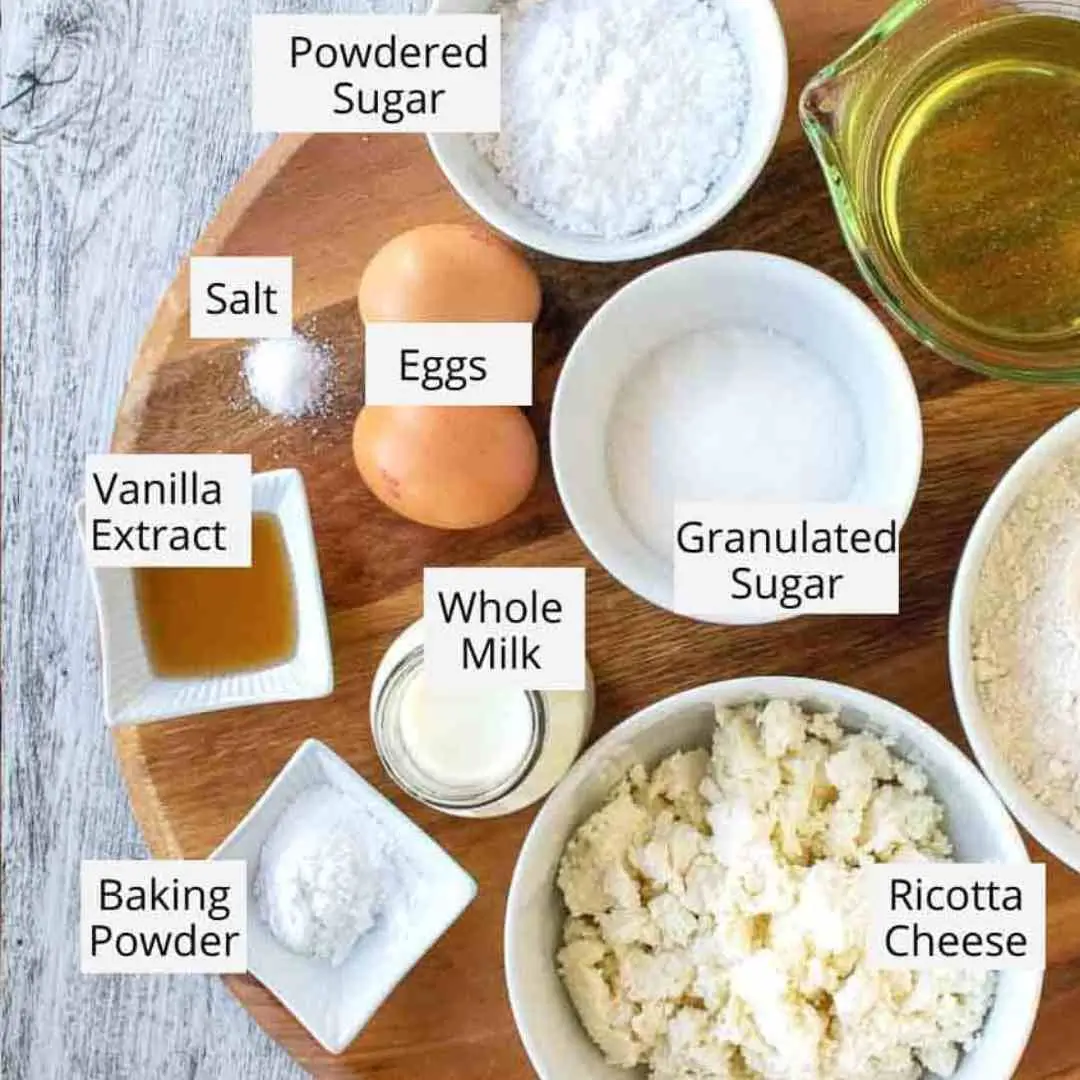Sfingi are one of those sweet little miracles that instantly transport you to a sunny Sicilian kitchen—no passport required. These light, fluffy fried pastries, often filled or topped with sweetened ricotta and a dusting of powdered sugar, are pure joy in every bite.
Traditionally made for St. Joseph’s Day, Sfingi have found their way into hearts and homes year-round thanks to their comforting texture and old-world flavor.
In our family, they’re a summer favorite too—whipped up on slow weekends when the kids want to help stir the batter and sneak tastes of ricotta.
Whether you’ve eaten Sfingi every March since childhood or are just discovering them now, this recipe brings that warm, Sicilian magic right to your own kitchen.
In this article, we’ll walk through everything you need to make perfect Sfingi—from ingredients and substitutions to frying tips, storage, and fun variations. By the end, you’ll know exactly how to recreate this Italian classic with confidence and love.
Ingredients to make perfect Sfingi
Making authentic Sfingi at home starts with a handful of simple ingredients—most of which you probably already have in your pantry. What makes these Sicilian pastries stand out is the ricotta-based dough, which gives them a uniquely soft and moist center. Here’s exactly what you’ll need:

-
2 cups (250g) all-purpose flour
This forms the base of your Sfingi batter. All-purpose flour offers the right balance of structure and tenderness. -
2 teaspoons baking powder
Essential for that light, airy puff. It helps the Sfingi rise beautifully as they fry. -
½ teaspoon salt
Just enough to enhance all the sweet and creamy flavors in the dough. -
1 cup (250g) ricotta cheese, well-drained
This is the soul of Sfingi. Ricotta makes the interior soft and rich. Be sure it’s well-drained—too much moisture can make the batter too loose. -
2 large eggs
These bind the ingredients together and add richness to the batter. -
¼ cup (50g) granulated sugar
A hint of sweetness inside the dough so each bite tastes just right. -
1 cup (240ml) whole milk
Adds moisture and creates a smooth, pourable consistency. Whole milk also enhances flavor. -
2 teaspoons vanilla extract
Brings a warm, sweet aroma that pairs beautifully with ricotta and sugar. -
Vegetable oil for frying
Choose a neutral oil with a high smoke point, like sunflower, canola, or peanut oil. This ensures the Sfingi get crispy without tasting greasy. -
Powdered sugar for dusting
Classic and necessary. Dust generously over warm Sfingi for that signature finish.
Ingredient Tip: For the best results, use fresh, high-quality ricotta. If it’s too wet, place it in a fine mesh strainer or cheesecloth-lined bowl in the fridge for a few hours before using. This step keeps your Sfingi batter just the right texture—thick but spoonable.
With your ingredients ready, you’re one step closer to that first glorious bite of freshly fried Sfingi.
Ready to get cooking?
Instructions
Making Sfingi isn’t complicated—it just takes a bit of love, a good mixing bowl, and hot oil. Here’s how to go from ingredients to golden perfection in just a few simple steps:
1. Make the Sfingi Batter
Start by grabbing your largest mixing bowl.
In it, whisk together the ricotta cheese, eggs, granulated sugar, and vanilla extract until the mixture is smooth and creamy. This step sets the flavor base for your Sfingi.
In a separate bowl, stir together the flour, baking powder, and salt.
Now, slowly add the dry mixture to the ricotta blend, alternating with the milk. Stir gently after each addition until everything is incorporated. You should end up with a thick but scoopable batter—similar to very soft cookie dough.
Pro Tip: Don’t overmix. A gentle hand keeps the Sfingi light and fluffy inside.
2. Heat the Frying Oil
Pour vegetable oil into a deep, heavy-bottomed pot or fryer. The oil should be at least 2 inches deep to allow the Sfingi to float and cook evenly.
Heat the oil to 370°F (188°C). Use a thermometer to make sure it stays steady—this temp ensures crispy outsides and cooked-through centers.
No thermometer? Drop a tiny bit of batter into the oil. If it sizzles and rises to the top quickly, the oil’s ready.
3. Fry the Sfingi
Using a small cookie scoop or two spoons, gently drop batter balls into the hot oil—about a tablespoon each.
Fry just 4–5 at a time to avoid overcrowding. Let them puff up and cook for about 4–5 minutes, turning occasionally, until they’re golden brown all over.
Watch the heat—if the oil gets too hot, the Sfingi will brown too quickly and stay raw inside.
4. Drain and Dust
Use a slotted spoon to lift the cooked Sfingi from the oil. Set them on a plate lined with paper towels to drain excess oil.
While still warm, dust generously with powdered sugar. Serve right away while the centers are still pillowy-soft and the outside has that irresistible light crunch.
Substitutions
One of the beautiful things about making Sfingi is how flexible the recipe can be. Whether you’re out of an ingredient or catering to a specific diet, there are several easy swaps that keep the texture light and the flavor delicious.
Ricotta Cheese Alternatives
If you’re out of ricotta or looking for a dairy-free version:
-
Cottage cheese: Blend it until smooth for a similar texture. Drain well before using.
-
Mascarpone: This will create a richer, creamier batter, though slightly less tangy.
-
Vegan ricotta: Great for dairy-free baking—just make sure it’s thick and well-drained.
Milk Substitutes
While whole milk gives the richest flavor, you can also use:
-
2% milk: Slightly lighter but still works well.
-
Almond milk or oat milk: For a dairy-free version. Choose unsweetened to avoid overpowering the vanilla.
-
Evaporated milk: A more intense, creamy flavor if you’re after indulgence.
Sugar Options
If you prefer natural sweeteners or are watching your sugar intake:
-
Coconut sugar: Adds a deeper, caramel-like sweetness.
-
Honey or maple syrup: Use sparingly to avoid thinning the batter—reduce the milk slightly if you add liquid sweeteners.
-
Stevia or monk fruit blend: For low-carb diets, use blends designed for baking.
Flour Adjustments
For different textures or dietary needs:
-
’00’ flour: A finer grind gives an extra tender crumb—popular in Italian pastries.
-
Gluten-free all-purpose blend: Works well in a 1:1 swap, though the batter may need an extra tablespoon of milk.
Frying Oil Choices
If you don’t have vegetable oil, try:
-
Canola oil: Neutral flavor and high smoke point.
-
Sunflower oil: Light, clean taste.
-
Peanut oil: Also suitable, but only if there are no nut allergies.
Remember, whatever substitution you choose, the goal is to preserve the tender, creamy texture that makes Sfingi so special.
With the right tweaks, you’ll still end up with a plate full of golden, irresistible treats.
Variations
Once you’ve mastered classic Sfingi, you’ll find it’s one of those recipes that invites a little fun. Whether you’re adding flavor, filling them up, or dressing them differently, there are countless ways to make them your own.

Filled Sfingi
Turn your Sfingi into creamy delights by piping them with filling after frying:
-
Sweetened ricotta: Mix ricotta with powdered sugar and a splash of vanilla. Use a piping bag to fill each Sfingi once cooled slightly.
-
Custard cream: For a Zeppole-style twist, use vanilla or chocolate pastry cream.
-
Nutella or chocolate ganache: For a crowd-pleasing hit, inject a bit of chocolate love into each one.
Tip: If filling, let the Sfingi cool just a bit to avoid melting the filling.
Flavor Infusions
Add subtle enhancements directly to the batter:
-
Citrus zest: A teaspoon of orange or lemon zest adds a bright, Sicilian flair.
-
Almond extract: A few drops deepen the flavor and pair beautifully with ricotta.
-
Cinnamon or nutmeg: Warm spices mix wonderfully into fall or holiday versions.
Toppings Beyond Powdered Sugar
Change things up from the traditional sugar dusting:
-
Drizzle with honey: Especially delicious with a sprinkle of crushed pistachios.
-
Roll in cinnamon-sugar: Great for a warm, churro-like finish.
-
Dip in chocolate: Once cooled, dip one half of each Sfingi in melted dark chocolate and let them set.
Seasonal Takes
-
Fall-inspired: Add pumpkin puree and pumpkin spice to the batter for an autumnal version.
-
Holiday edition: Top with red and green sprinkles, or add crushed peppermint to the sugar for Christmas parties.
No matter how you vary them, these little fritters keep their core charm—crispy outside, fluffy inside, and impossible to stop at just one.
Equipment
To make perfect Sfingi at home, you don’t need fancy bakery tools—just a few reliable kitchen essentials. These tools help ensure your batter comes together smoothly and that your frying process is safe and successful.
Mixing Essentials
Large mixing bowl: You’ll need one for combining the ricotta, eggs, and dry ingredients. Go for a bowl with high sides to prevent splatter.
Medium bowl: Great for sifting or combining the dry ingredients separately.
Whisk or hand mixer: A simple whisk works, but a hand mixer makes it easier to blend the ricotta mixture until creamy.
Measuring Tools
Measuring cups and spoons: Precision is key, especially with baking basics like flour and baking powder.
Digital kitchen scale: Optional but great for consistent, accurate baking.
Frying Setup
Deep heavy-bottomed pot or Dutch oven: Choose one that holds heat well and has high sides to prevent splashing.
Thermometer: Crucial for maintaining the ideal oil temperature of 370°F (188°C). A clip-on candy or deep-fry thermometer works perfectly.
Slotted spoon or spider strainer: For safely lifting the hot, golden Sfingi out of the oil.
Finishing and Serving
Paper towels: Lay them on a baking sheet or large plate to drain excess oil from freshly fried Sfingi.
Wire cooling rack: Optional but helps keep them crisp after draining.
Sifter or fine-mesh strainer: For dusting the tops with powdered sugar evenly.
Piping bag (optional): If you want to fill your Sfingi with ricotta cream or custard, this makes the job neat and easy.
Having the right tools on hand doesn’t just make cooking easier—it ensures your Sfingi turn out beautifully every time, from prep to plate.
Storage
Sfingi are at their absolute best right after frying—crispy on the outside, soft and airy inside, and warm enough to melt in your mouth. But if you do have leftovers (a rare occurrence in our house), here’s how to store them without sacrificing too much of that fresh-from-the-oil magic.
Short-Term Storage
Room temperature:
Store cooled Sfingi in an airtight container lined with paper towels to absorb any extra oil. Keep them at room temperature for up to 1 day. They’ll lose some crispness but remain delicious.
Tip: To bring them back to life, pop them in a 350°F (175°C) oven for 5–7 minutes before serving.
Longer Storage
Refrigeration:
Not recommended. The fridge tends to make fried dough soggy and dulls the flavor. However, if you’ve filled your Sfingi with ricotta or cream, you must refrigerate them to keep the filling safe. In this case, store in a container with a loose lid and eat within 24 hours.
Freezing:
While not ideal for already fried Sfingi, you can freeze the unfried batter. Spoon it into an airtight container and freeze for up to 1 month. When ready to use, thaw in the fridge overnight, then fry as directed.
Avoid freezing fully cooked Sfingi—they lose their signature texture and the powdered sugar will dissolve.
Reheating Tips
-
Oven: Best method. Preheat to 350°F and heat for 5–7 minutes until warm and lightly crisped.
-
Air fryer: Quick and effective. Heat at 320°F for 3–5 minutes.
-
Microwave: Not recommended—it softens and steams the fritters, making them chewy.
Proper storage lets you enjoy your Sfingi for a little longer, though if your house is anything like mine, there won’t be many left by the end of the day!
Tips for Success
If you’re making Sfingi for the first time—or even the fifth—these tips will help you get that perfect crispy outside and soft, creamy inside every time. It’s the little things that make a big difference!
Use Well-Drained Ricotta
Ricotta adds richness and softness, but too much moisture will make your batter runny.
Tip: Scoop ricotta into a fine-mesh strainer or wrap it in cheesecloth, then refrigerate for 1–2 hours before using. Dry ricotta gives the batter just the right structure.
Maintain the Right Oil Temperature
Sfingi need oil that’s hot enough to crisp the outside but not so hot that they burn before cooking through. Keep your oil steady at 370°F (188°C). Use a thermometer—guessing leads to greasy or raw centers.
If the Sfingi brown too fast, the oil is too hot. If they absorb oil or fall apart, it’s too cool.
Fry in Small Batches
Overcrowding the pot drops the oil temperature and makes uneven results. Fry just 4–5 Sfingi at a time, giving them space to puff up and turn easily.
Don’t Overmix the Batter
The goal is light and airy—not chewy or dense. Mix just until the flour is combined. Overmixing develops gluten, which can weigh the fritters down.
Scoop Consistently
Use a small ice cream scoop or tablespoon to portion the batter. This helps them fry evenly and look uniform (bonus: no fighting over the biggest one).
Let Them Drain Properly
After frying, rest the Sfingi on paper towels or a cooling rack to get rid of excess oil. Don’t stack them while hot—they’ll steam and lose that lovely outer crunch.
Dust While Warm
For best results, sprinkle powdered sugar on while they’re still warm. The sugar will lightly melt and stick without becoming soggy.
Remember: fresh, warm Sfingi with a soft, fluffy center and sweet dusting on top are what you’re after. Follow these tips and you’ll be pulling off bakery-level results right in your own kitchen.
Serving Suggestions
Sfingi are best served fresh and warm, with a light dusting of powdered sugar. Here’s how to enjoy them to the fullest:
-
Traditional style: Serve with espresso or cappuccino after Sunday dinner or on St. Joseph’s Day.
-
Party platter: Pair Sfingi with cannoli and biscotti for a festive Italian dessert tray.
-
Filled delight: Pipe sweet ricotta or chocolate cream inside and garnish with candied orange or a cherry.
-
Dipping fun: Offer honey, fruit jam, or chocolate sauce for an interactive dessert bar.
-
Breakfast treat: Warm a few leftover Sfingi in the oven and enjoy with a strong cup of coffee—just like Nonna would.
Whether served at a family feast or as a sweet bite on a quiet morning, Sfingi bring a comforting, homemade touch to any moment.
What’s the difference between Zeppole and Sfingi?
Zeppole are made with choux pastry and filled with custard, while Sfingi use ricotta-based dough and are often filled with sweetened ricotta. Both are fried and tied to St. Joseph’s Day, but their textures and flavors are distinct.
What is the Italian pastry for St. Joseph’s Day?
Sfingi and Zeppole are both traditional, but in Sicily, Sfingi take center stage—fried, creamy, and celebratory.
Why do Italians eat Zeppole?
Zeppole and Sfingi are eaten on St. Joseph’s Day to honor the saint and celebrate family, tradition, and blessings.
What are the Italian pastries on The Sopranos?
You’ll see cannoli and sfogliatelle on the show, but Sfingi are a real-life staple in many Italian-American homes—even if Tony never mentioned them.
Conclusion
Sfingi are more than just fried dough—they’re a piece of Sicilian history, a symbol of celebration, and a cozy reminder that some of the best desserts are the simplest. Whether you’re making them for St. Joseph’s Day, a weekend family treat, or just to try something new, Sfingi deliver every time: crispy on the outside, soft and creamy inside, and always made with love.
With the right ingredients, a bit of care, and these step-by-step tips, you’ll be whipping up bakery-worthy Sfingi in your own kitchen. Trust me—once you see the smiles they bring (especially dusted in sugar and eaten still warm), you’ll be making them again and again.
Print
Sfingi: A Sweet Sicilian Treat for Summer Days
- Total Time: 25 mins
- Yield: 20 Sfingi 1x
Description
Traditional Sicilian Sfingi are fluffy ricotta doughnuts, fried to golden perfection and dusted with powdered sugar. A St. Joseph’s Day favorite that’s easy enough to enjoy anytime.
Ingredients
2 cups (250g) all-purpose flour
2 teaspoons baking powder
½ teaspoon salt
1 cup (250g) ricotta cheese, well-drained
2 large eggs
¼ cup (50g) granulated sugar
1 cup (240ml) whole milk
2 teaspoons vanilla extract
Vegetable oil for frying
Powdered sugar for dusting
Instructions
1. Whisk together ricotta, eggs, sugar, and vanilla in a bowl until smooth.
2. In a separate bowl, mix flour, baking powder, and salt.
3. Gradually add dry ingredients and milk to ricotta mixture; stir until thick batter forms.
4. Heat oil to 370°F (188°C) in a deep pot.
5. Drop tablespoon-sized scoops of batter into oil; fry 4-5 minutes until golden.
6. Drain on paper towels and dust with powdered sugar. Serve warm.
Notes
Make sure to drain the ricotta well to avoid soggy batter.
Fry in small batches to keep oil temperature steady.
Best enjoyed fresh, but can be reheated in the oven.
- Prep Time: 10 mins
- Cook Time: 15 mins
- Category: Dessert
- Method: Frying
- Cuisine: Italian
Nutrition
- Serving Size: 1 Sfingi
- Calories: 110
- Sugar: 6g
- Sodium: 70mg
- Fat: 5g
- Saturated Fat: 1.5g
- Unsaturated Fat: 3g
- Trans Fat: 0g
- Carbohydrates: 13g
- Fiber: 0.3g
- Protein: 3g
- Cholesterol: 30mg
Keywords: Sfingi, Italian donuts, ricotta fritters, Sicilian pastries

